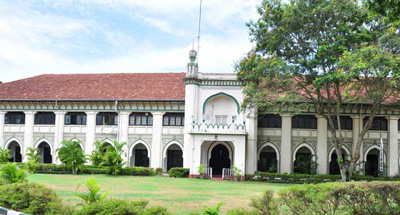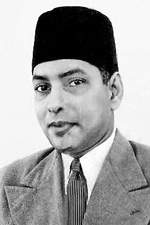Sunday Times 2
A.M.A. Azeez’s intellectual legacy has stood the test of time
View(s):Dr. A.M.A. Azeez, the legendary principal of Zahira College, Colombo, was one of the celebrated intellectuals of his generation. He not only led the premier Muslim educational institution to new heights of excellence — both in studies and sports — but also served as a Senator and a member of the Public Service Commission (PSC) in the 1950s and 1960s.
| Memorial Oration The 42nd Dr. A.M.A. Azeez commemoration meeting and the memorial oration will be held on Thursday November 26 at 4.30 p.m. at The Excellency, 4, Charlemont Road, Wellawatte, Colombo 6. M.S.M. Anes, retired professor of philosophy, University of Peradeniya and Chairman, All Ceylon Muslim Educational Conference, will deliver the oration on the subject “Muslim Modernism and Reformative Process in the Field of Education, a Sri Lankan Experience”. The meeting will be chaired jointly by Khalid M. Farouk, President, Dr. A.M.A. Azeez Foundation, and Sadique Saleem, National President, All Ceylon YMMA Conference. | |
As a cub reporter for the then “Ceylon Observer,” I had the privilege of watching him in a vibrant verbal battle with a feisty newspaper editor at a diplomatic reception in Colombo in the late 1960s. When the editor criticised the PSC for “not living up to its ideals”, Azeez shot back: “Nor is the Press”, (which at that time was a political tool in the hands of the ruling party). And he was dead on target.
Born on October 4, 1911, Azeez passed away on November 24, 1973 — at the relatively young age of 62. But he left behind a lifetime of memories — and an intellectual legacy that has stood the test of time. Many events in Azeez’s journey are milestones in Zahira’s history. But covering the entire spectrum of his achievements could well be the subject of a future doctoral thesis.
So, a tribute to his achievements in a single article will fail to do justice to his enduring legacy. But then, a journey of a thousand miles has to begin with a single step. When Azeez went on a three-month educational tour of the United States in 1952 — on a Smith-Mundt Leadership Grant — he spent time in some of most prestigious American Universities, including Harvard, Columbia and Stanford.
Perhaps, not in the wildest of my dreams would I have imagined that 20 years later I would find myself as a graduate student at Columbia University in New York reading for my Master’s Degree in Journalism — perhaps the only old Zahirian of the Azeez and post-Azeez era. But, regrettably, I didn’t get the opportunity of telling him that I followed in his footpath.
During my undergraduate days at Peradeniya, I never missed visiting him at his Barnes Place residence whenever I was in Colombo during my vacation break. We had endless discussions on politics, economics, philosophy, religion and international affairs.
I was amazed at his repository of knowledge and the intellectual depth of his arguments proving that he was a voracious reader – and where the walls of his home library were lined up with books stacked to the ceiling. While I was still a student at Zahira, he returned from the United States with first hand information both of the American school system and teacher training institutions.

Many events in Azeez's journey are milestones in Zahira's history
His itinerary included visits to several US public, parochial and private schools, and schools exclusively designated for native American children in Indian reservations. And this was also the time when he was President of the All Ceylon Union of Teachers.
Student Council reform
By the late 1950s, he set up the first-ever Students’ Council at Zahira — a direct result of his visit to the US — in which the students stood on an equal footing with the principal in offering ideas and proposals for the betterment of the College.
The Council, perhaps the first of its kind at that time, met every fortnight to interact with the principal, the deputy principal and the vice principal. Azeez, who was taking his students into his confidence, not only entertained ideas and suggestions but was also receptive to complaints.
Clearly, it was a concept far ahead of the times — and perhaps one of the few or the only College to have a strong rapport between the Principal and the students. We met in his office, at least once or twice a month, for an animated discussion over tea and coffee – on subjects ranging from an evaluation of the school’s curricula to the performance of Zahira’s sports teams. We found ourselves in a comfort zone being recognised as part of a team to help accelerate Zahira’s progress.
He also encouraged the publication of Az-Zahira, a monthly college newsletter — cranked out on a Gestetner machine — to tap the latent writing skills of Zahirians. The newsletter was written and edited largely by two editors, A.R.M. Zuhair and myself — both of whom had the privilege later in life to be contemporaries at the University of Ceylon at Peradeniya.
Speaking of Peradeniya, one of the academically spectacular achievements of the Azeez era was the 1958 batch to the University’s Arts Faculty — the largest single batch at that time. A record number of Zahirians — nine in all — gained entrance to the then University of Ceylon, outdistancing some of the leading public schools in the country.

Dr. A.M.A. Azeez: Visionary educationist
The list (all direct admissions) published in the Sunday Times of February 23, 1958 read:
Zahira College: A.S. Ahamed Farooq, M.T.M. Hilmy Manzil, A.M.M. Mansoor, A.H.M. Nizamdeen, M.S.M. Nalim, M.A. Perera and T.M. Thalifdeen. Added to the list later were Farook Saleem and Rizwy Abdurahman (who gained admission after the Viva). In the same year there were two Zahirians who gained admission to the Engineering Faculty bringing the total to eleven.
During Azeez’s tenure as principal, more than 150 Zahirians entered the University of Ceylon.
And all of these achievements were shadowed by the overwhelming figure of Azeez, still the Principal of Zahira at that time and also a member of the University Senate. As a team, the Zahirians at Peradeniya were affectionately called “the Arab League”. And this included Hamza Haniffa, who had gained admission the previous year.
In the late 1950s and 1960s, the Zahirians maintained a high profile at the University Campus. The editor of the University Sports Magazine in 1960-1961 was a Zahirian. So was the editor of the University Muslim Majlis magazine.
At a popular radio quiz show matching the intellectual wits of the compere against the contestants, the only one to crack the jackpot — a minor fortune of Rs. 1,000 at the time — was a first year Zahirian, who beat a slew of professors and lecturers lined up on stage at the University Arts Theatre, poised to grab the prize money and display their intellectual prowess.
Zahirian dominance
But the Zahirians who entered the University in the late 1950s and early 1960s did not confine themselves only to intellectual pursuits. The 1958 batch of Zahirians produced a University captain of boxing, M.S.M. Nalim; a two time winner of the first-ever “Mr. Campus” physique contest Hilmy Manzil; a captain of wrestling Hamza Haniffa; and a captain of athletics Farook Saleem. Joining Farook, both in athletics and rugger, was Rizwy Abdurahman.
Nalim, one of the most accomplished boxers in the campus had a devastating left hook which floored many an opponent. As a result, he reigned supreme as an unchallenged boxer. Derek Raymond, the University boxing coach at that time, who also doubled as a coach for the boxing team at St. Sylvester’s College in Kandy, was an Empire Games boxer.
When he couldn’t find a challenger for Nalim, Derek was forced to hold exhibition bouts between Nalim and some of the reputed Stubbs Shield boxers from St. Sylvester’s. And that was until the arrival of a versatile boxer from Christian College, Kotte who decided to take on Nalim. Surprisingly, he went two rounds with Nalim — and on the third round, Nalim knocked him out cold and he had to be carried out of the ring on a stretcher — feet first.
The campus was stunned. So, was the Director of Physical Education Leslie Handunge, himself an Olympics boxer of a bygone era. But that devastating punch by an old Zahirian also made history because shortly after that bout, the University decided to ban boxing from its sports curricula. It was an end of an era in the history of sports at Peradeniya.
However, that did not deter the Zahirians because they were equally accomplished in a sport that replaced boxing: Wrestling. Collectively, the Zahirians helped Marrs Hall win the annual Gold Cup for exceptional all-round athletic performance, an achievement whose celebrations reverberated throughout the Peradeniya campus. To be introduced as a Zahirian at that time was a moment of pride and glory. These were all Zahirians nurtured and bred in the Azeez era.
Besides the achievements of Zahirians at Peradeniya, the athletic glories under Azeez were legion: the first student to win the Queen’s Cup for rifle shooting; winners of the Tarbat Shield for soccer and public schools championship in wrestling, among many others.
When Azeez came to Zahira, the Muslims were known to be lagging far behind in higher education — in Arts, Medicine and Sciences. Just as Britain was once dismissed as a “nation of shopkeepers”, the Muslim community was being offered a back-handed compliment as a community of businessmen.
But Azeez wanted the community to go far beyond trade, commerce and industry. As a man of vision, he knew the community was in need of professionals, including doctors, engineers, accountants, writers, scientists, civil servants, architects, diplomats, scholars, journalists and teachers.
And he reached these goals long before he left Zahira.
When he quit the prestigious Ceylon Civil Service (CCS) to take over Zahira College, Colombo, in 1948, he sacrificed a potentially bright professional career in the cause of his community. If Al Haj T.B. Jayah, the first principal, laid the foundation for Zahira, Azeez built the super-structure.
Outside Zahira, Azeez fathered the Ceylon Muslim Scholarship Fund and the All-Ceylon YMMA Conference, two of his other legacies to the Muslim community. In public life, he was appointed Senator in 1952 and was bestowed with the title of Member of the British Empire (MBE).
At the same time, he was a member of the Public Service Commission (PSC) and was also elected to the University Senate. In national politics, he was a member of the working committee of the United National Party, only to quit in 1956 over the Official Language Bill.
But his monumental achievements were at Zahira, which prompted a former Sri Lankan President to describe Zahira as “one of the greatest public schools in our country”.
(Thalif Deen was a student of Zahira College, Colombo during the Azeez era. He graduated from the University of Ceylon with a Bachelor’s Degree in Economics in 1962. He was a Fulbright Scholar at Columbia University, New York and obtained his Master’s Degree in Journalism. He has won many awards in journalism and shared the Gold Medal for coverage of the humanitarian and development work of the United Nations in 2013. A former military editor of Jane’s Information Group in the US, he is presently the UN Bureau Chief & Regional Director for Inter Press Service (IPS) news agency)

